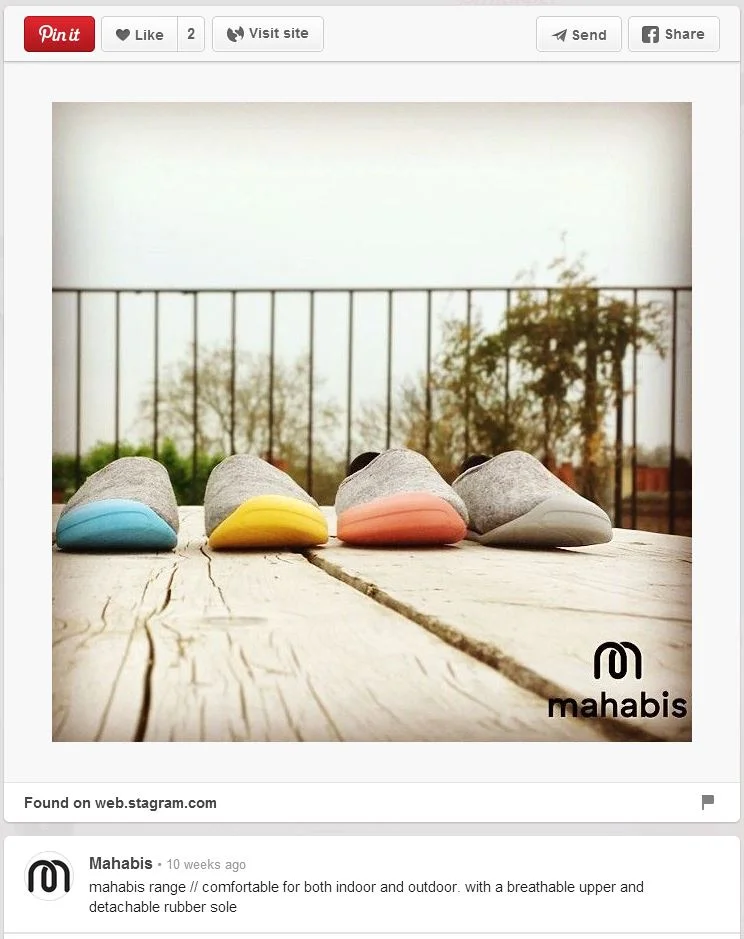How to Launch A Product Using Social Media (Mahabis Slippers Case Study)
/If you'd mentioned the word "slipper" to me a couple of months ago, my first thought would have been of a drab, old-fashioned item of footwear (flowery design for women, checked for men), most likely to be worn by my parents of grandparents. That was until I stumbled across Mahabis, a British company who proclaims to be "reinventing the slipper // for everyday adventures," and my original notion has completely changed.
Mahabis has spent over a year building interest in its brand and product up to its launch, and their use of social marketing really caught my eye. What follows is just a sample of what Mahabis has been up to in social spaces, and I'm sure that a great many of you reading will be inspired by their approach and be able to weave some of the ideas into your own strategy.
Consistent branding
Across its social media profiles and website, Mahabis' branding remains consistent, reflecting the young, cool, minimalist style of its product. Wherever a customer discovers them online, the impression given through its visual content is the same. Mahabis' photos are original, and consistently high quality.
Mahabis on Facebook
Mahabis on Twitter
Mahabis website
Strong brand culture
One of cleverest moves made by Mahabis is the way that it has built a whole culture and lifestyle around its slippers. Mahabis lets us know that its products is not just slippers and the people who wear them aren't just looking for practical, comfy footwear. The Mahabis brand has a life of its own - it is humanised - and the showcasing of its interests and influences have been used heavily across social media, ranging from music and design to travel and architecture. When you show people that your business exists beyond the product or service you are selling, people will be much more inclined to buy into it and incorporate those values and ideals into their own lives.
mahabis places // see why our range is named after larvik in norway http://t.co/e0BEB5e6VO #mahabis #slippers
— mahabis (@mahabis) July 16, 2014mahabis inspiration // photographer matthias heiderich http://t.co/6wLq1aL4s8 pic.twitter.com/28xv02sjzD
— mahabis (@mahabis) July 10, 2014mahabis design // a century of chairs in one infographic by @TomFaulkner pic.twitter.com/N2LBHbjD4i
— mahabis (@mahabis) June 27, 2014mahabis sounds // mid week pick-me-up from @alt_J http://t.co/3EBOiJ7C0z
— mahabis (@mahabis) June 25, 2014Showing behind the scenes
From product development to launch, Mahabis invited its customers "behind the curtain" for a sneak peek at what it was up to. This transparency not only allows people to feel closer to the brand as a trust-building exercise, but also helps to build anticipation which peaks all the way up to the point that the slippers go on sale.
Selling the benefits (and product)
As well as highlighting the lifestyle element of its brand, Mahabis uses social media to sell the practical benefits of its product, but refrains from being too pushy. After all, the vast majority of people do not tolerate direct selling very well on Facebook, Twitter, Pinterest, et al. In the following examples, a variety of images are used to achieve the desired effect, from staged-but-stylised photoshoots, to annotated product images, to simple shots that show off the full range available.
Exclusive offers
To mark the launch of its slippers, Mahabis released a Facebook-only 15% discount code, distinctly marking it "social15" to make tracking nice and easy against similar promotions set up elsewhere. When fans know that a benefit of following you on social media is exclusive discounts and offers they won't get anywhere else, so the incentive to keep tabs on your activity is increased.
Stellar customer service
Just as social media gives you access to your customers 24 hours a day, so many of them expect to be able to reach you at all times, too (within reason!). In this respect, Mahabis does well to respond to customers' questions in a friendly, helpful manner and - perhaps more importantly - really rather quickly. In the examples below, responses to customer queries arrived in just minutes.
Paid advertising
Like any kind of marketing you choose to carry out, social media should be allocated an advertising budget in order to amplify your reach and chances for engagement. I've seen several Sponsored posts and sidebar ads from Mahabis floating around in my News Feed on Facebook, including the following:
Showcasing its customers
From the moment Mahabis launched its slippers in July, it has been keen to make its customers feel part of its brand image. After requesting snaps from its customers via Facebook, the following examples are photos "re-grammed" to the brand's official Instagram account. Notice how the original photo-taker is credited (making them feel special, likely to share with their friends), the images fit seamlessly amongst Mahabis' own marketing, and how the brand culture is compounded through each photo caption.
A few quick questions (and their answers) for Mahabis
Andrew: In overall marketing terms, how big a consideration has been/is social media for building the mahabis brand - from pre-launch to the present, and future?
Mahabis: A huge consideration. It’s integral to who we are, not a bolt on. Our reservation page was open for about 3 months and was driven largely on and by social media and the response was incredible. As a medium it enables an incredible amount of feedback and excitement to both be generated and shared. So many of our awesome customers have shared selfies of themselves, from the most crazy and random places, it doesn’t just make us happy to see it, it makes us feel like we already have an active and engaged community of mahabis wearers!
Andrew: What are your goals for using social media, and which social channel has been the most effective in helping you to reach them?
Mahabis: We launched on Facebook, Twitter, Instagram and Pinterest. We don’t really discount any channels and all have been incredibly effective for different things. But the platforms are all really powerful. As a brand that is incredibly focussed on online, what social allows us to do is to create, define and present our brand in every way possible, from imagery to tone of voice.
Andrew: How do you plan and manage campaign and content creation on a day-to-day basis?
Mahabis: We work in a number of ways from schedules to specific campaigns, look out for our #artofchill series for example where we will be creating content on incredible ways to chill and relax around the world. So in general our content is created in two ways, either planned based on our brand activity or ad-hoc and based on how people are engaging with us. This allows us to be both pro-active and reactive.
Over to you
Mahabis has done a great job of turning what some might ordinarily see as a "boring" product, into something that is cool and desirable, and it has been able to utilise a variety of social media channels to find and engage with a receptive audience. What are your thoughts about Mahabis' social media strategy? Are you doing something similar? Were you inspired by any of the ideas you saw? Let me know in the comments below!
Andrew Macarthy is a social media consultant and the author of the #1 Amazon Web Marketing Bestseller, 500 Social Media Marketing Tips.
Buy 500 Social Media Marketing Tips
Amazon US: http://www.amazon.com/dp/B007L50HE6
Amazon UK: http://www.amazon.co.uk/dp/B007L50HE6
Follow Me:
http://www.facebook.com/500socialmediatips/
http://www.pinterest.com/andrewmacarthy
http://www.twitter.com/andrewmacarthy
http://www.youtube.com/500socialmediatips
















